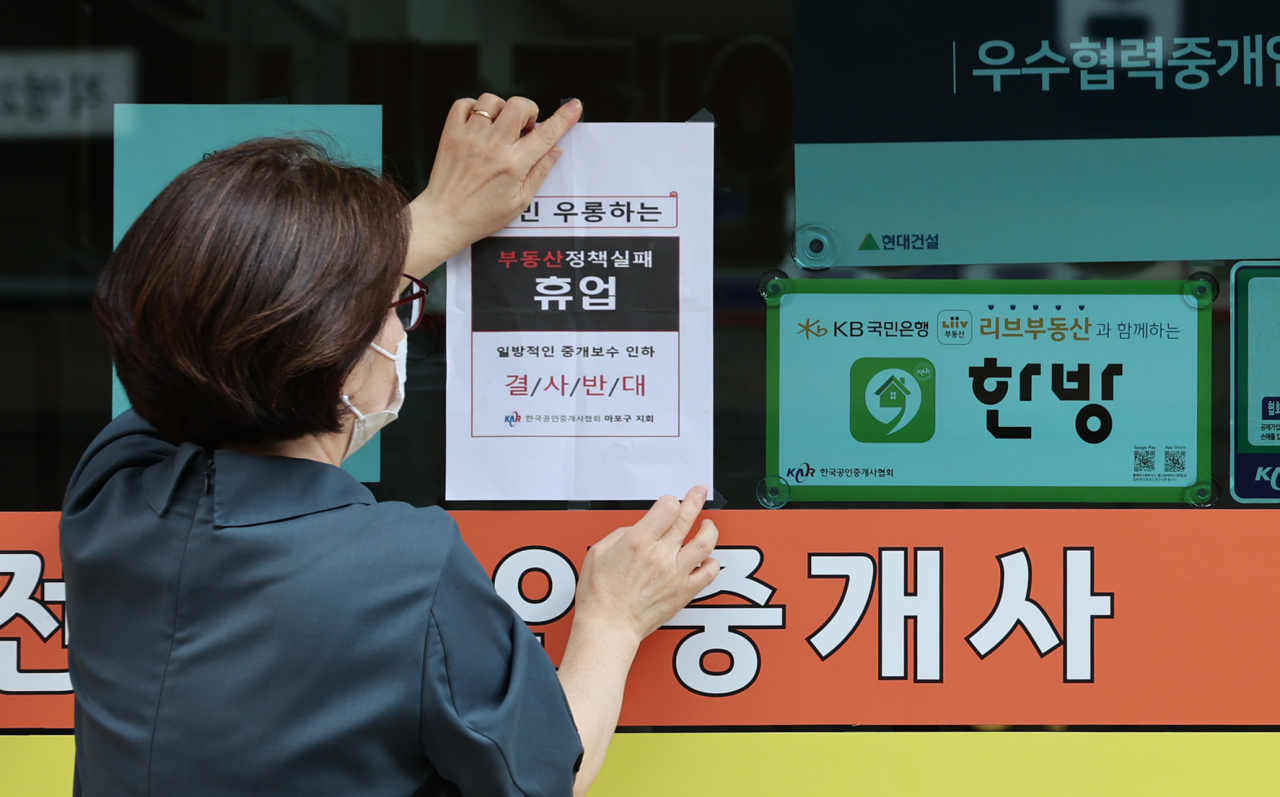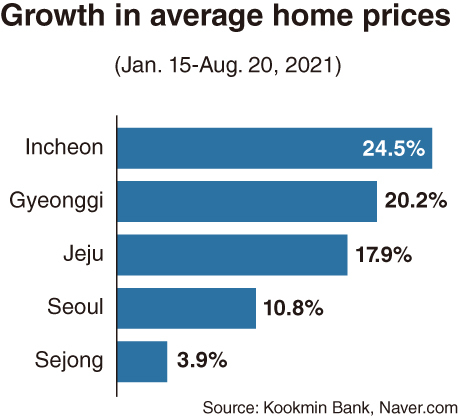[News Focus] Home prices in Seoul up 10% since January
Prices grow by 20% in Gyeonggi, 24% in Incheon
By Kim Yon-sePublished : Aug. 24, 2021 - 17:35

SEJONG -- Housing prices in Seoul, Gyeonggi Province and Incheon have continued to spike in recent months, with mixed prospects on whether the surge could be tamed with government-led property regulations such as tighter mortgage rules.
Real estate figures in the three areas act as a barometer for home prices nationwide. As of July, 50.3 percent of South Korea’s 51.67 million population were residing in the capital-centered metropolitan area.
The average trading price of homes in Seoul climbed by 10.8 percent over the past seven months to 38.18 million won ($32,500) per 3.3 square meters on Aug. 20, according to KB Kookmin Bank and Naver.com. Prices on Jan. 15 were 34.45 million won.
This means that the average price of an 84-square-meter home (a popular size in South Korea) in Seoul would cost 971 million won. A same-sized flat in an apartment building in the same location is likely to cost far more.

Gangnam-gu and Seocho-go, the two major wealthy districts of the 25 administrative wards in Seoul, saw the price rise by 8.4 percent and 11.3 percent, respectively, over the corresponding period to 66.29 million won and 64.81 million won per 3.3 square meters.
That would put an 84-square-meter unit in Gangnam-gu at around 1.68 billion won and 1.64 billion won in Seocho-gu. Same-sized units in apartment complexes in those districts are likely to hover between 2.5-3.5 billion won.
In online communities, commenters predict that home prices in Seoul would eventually be tamped down, calling the price tags “irrational.” They say the tight mortgage rules and suspension of mortgage issuance of some banks will drive more homeowners to sell, outnumbering buyers in the capital.
But some others pointed out that rolling out a series of regulations without sufficient new housing supply have only continued to fan apartment prices during the Moon Jae-in administration. They forecast a further spike in Seoul home prices after a fine-tuning that could last weeks or months.
Price growth in Gyeonggi Province and Incheon far outpaced that of the capital with figures posting 20.2 percent and 24.5 percent, respectively, in less than eight months since Jan. 15. The price per 3.3 square meters was 18.64 million won in Gyeonggi and 13.72 million won in Incheon as of Aug. 20.
Incheon’s Songdo-dong recorded a 23 percent growth to 596 million won for 84-square-meter homes. A same-sized unit in Seongnam City's Bundang-gu and Gwacheon City in Gyeonggi climbed to 987 million won and 1.36 billion won, respectively.
One noteworthy development is the surge in average trading price of homes in Gyeonggi’s Siheung and neighboring Ansan (Danwon-gu). Prices shot up 35.5 percent and 33.4 percent on the back of expectations that new metro lines linking Seoul would be built in the area.
Since May 2017, when the Moon administration took office, apartment prices have shot up 100-200 percent in Seoul, Gyeonggi and Incheon.
For other regions across the country, prices climbed by 17.9 percent to 14.32 million won per 3.3 square meters in Jeju Province, 13.7 percent to 12.57 million won in Daejeon, 12.5 percent to 13.66 million won in Busan, and 8.2 percent to 12.04 million won in Daegu.
A real estate agent said that “the number of homebuyers in Incheon’s Songdo-dong and Jeju have surged, as many households chose to seek their children’s admission at international schools in Korea, instead of sending them abroad amid the pandemic.”
While Ulsan and Gwangju posted relatively mild growths of 7.2 percent and 6.6 percent, the figure for Sejong was the lowest at 3.9 percent in the corresponding period.
The record-breaking price growth in the administrative city of Sejong since early 2020 has stalled in recent months, after some public agency officials were linked to a property speculation scandal there uncovered earlier this year.
Nevertheless, the future direction of home and land prices in the city is still drawing nationwide attention as a large-scale land development is still underway and its population is continuously increasing.
By Kim Yon-se (kys@heraldcorp.com)




![[Herald Interview] 'Amid aging population, Korea to invite more young professionals from overseas'](http://res.heraldm.com/phpwas/restmb_idxmake.php?idx=644&simg=/content/image/2024/04/24/20240424050844_0.jpg&u=20240424200058)












![[KH Explains] Korean shipbuilding stocks rally: Real growth or bubble?](http://res.heraldm.com/phpwas/restmb_idxmake.php?idx=652&simg=/content/image/2024/04/25/20240425050656_0.jpg&u=)

